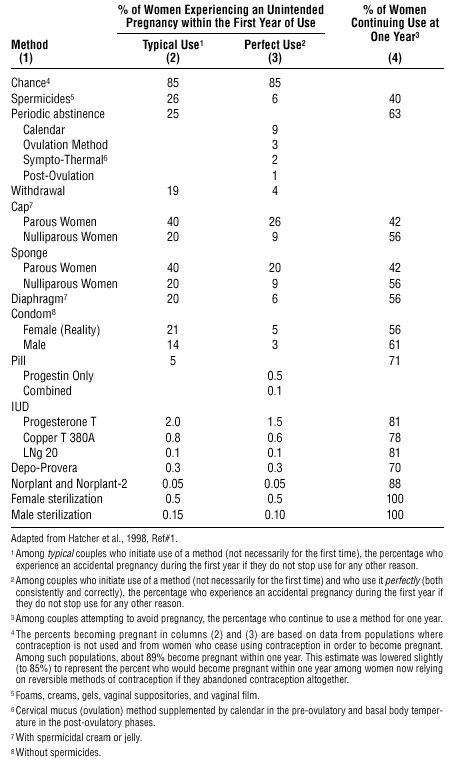Condoms Don’t Work Nearly As Well As You Might Have Thought
I was at Planned Parenthood recently. I was sitting around in the waiting room reading all the literature on the walls and I came across a weirdly shaped pamphlet. Turns out, it’s a pamphlet for the Mircette birth control pill. It was oddly shaped because it had a pocket inside it with a map-looking thing in it. I idly opened the map-looking thing… and kept opening it… and kept opening it… into an 11″ x 25″ paper with itty bitty print on both sides. Yow.
I saw a pretty picture of the Mircette molecule. Some pretty charts on “Circulatory Disease Mortality Rates per 100,000 Woman-Years by Age…” You know, the usual. I was keeping it light so I kept to the charts and graphs. I came across one that… well, it’s heavy. Here it is, lifted from the Mircette page:

Do you remember your statistics? Take a look at line about male condoms. This says that if a couple uses condoms regularly as their only birth control method, they have a 14% chance of becoming parents after a year. Compare that to if they didn’t use anything at all; they’d have an 85% chance of conceiving. Said another way, you are about 1/6th as likely to conceive when using condoms. If, on the other hand, you’re on the pill, you’re somewhere between 1/170 and 1/850 times as likely to conceive.
Of course, condoms are good at preventing the spread at disease. And they are good as a “multiplier” when you use multiple birth control methods. But if all you use are condoms for birth control, then you’re playing Russian Roulette with your future.
I would also point out that condoms are one of those methods for which there is a huge gap between the failure rate in perfect use and the failure rate in actual use. Translated, that means that if a couple says they are using condoms for birth control, there is a very high probability that at some point they will say, “Oh, I can go without just this once,” and end up pregnant. (Notice that 39% of couples using condoms have actually given them up entirely within a year.) I mention this only because some of the proponents of abstinence-only education will use statistics like these to argue that condoms are so ineffective that you have to use abstinence if you want to have any reasonable chance of avoiding pregnancy.
This chart also exposes the logical problem with those who argue that the pill or the IUD have such terrible side effects that it is better to use hormone-free methods like the diaphragm. The diaphragm is safer than the pill only if the woman would get an abortion if the diaphragm failed. If the women would carry the pregnancy to term if her contraceptive failed, the side effects of the pregnancy would far outweigh the side effects of the pill or IUD.